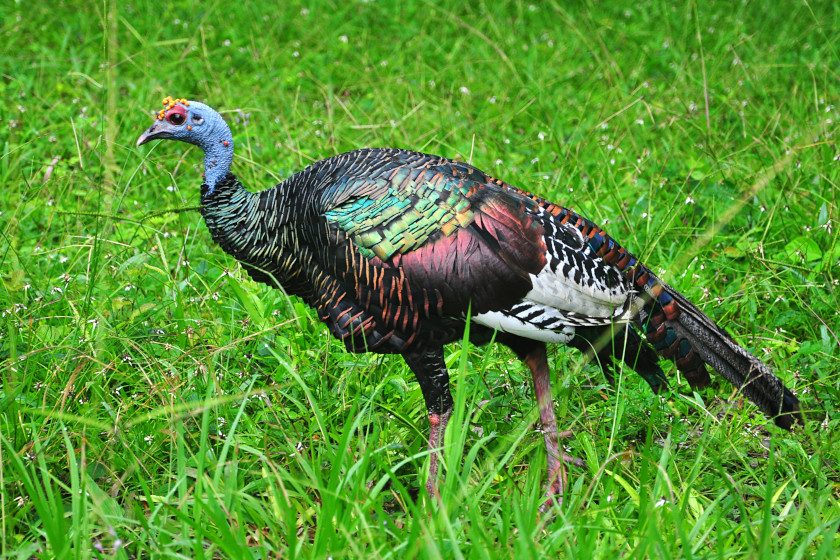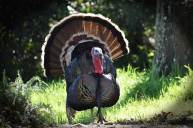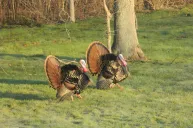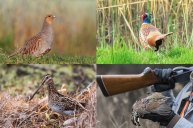The Ocellated turkey may be the most beautiful and unique game bird in North America. It is said that the ancient Mayans revered these turkeys, considering them a powerful and valued bird for their iridescent feathers and their leg spurs. Their metallic feathers shimmer in a broad band of colors from electric blue to green, which grow more vivid on the wings around a bronze-orange and white tail feathers. Just based on appearance alone, it's like no other turkey out there. The simple fact that you need to travel to the jungles of Mexico or Central America just to hunt one makes the hunt for one of these animals even more unique. After all, there's not many chances to go turkey hunting in a tropical setting. And for anyone who wants to complete a World Slam or a Mexican Slam, the Ocellated is a required bird. There's nothing easy about putting together an ocellated turkey hunt since it requires a great deal of travel. But the adventure of getting there and finding them is half the fun.
Where To Find Ocellated Turkeys
However you look at it, the Ocellated turkey is still a wild game bird that is related to the other species of wild turkeys in North America (if you didn't know, Mexico is considered a part of North America). One of the differences in this species is that it exists almost exclusively in the Yucatán Peninsula, and in just a bit of Belize and Guatemala. Most hunters who decide to pursue the Ocellated choose to go to Mexico and the Yucatán. Mainly because it's the easiest place to reach. There's always a ton of flights going in and out of Cancun for tourism purposes anyway.
It's a variable thing for sure, but an ocellated turkey hunt can cost anywhere from $2,500 to $3,000 depending on the outfitter. Some guides may also have trophy fees, so it's worth asking before you book. If you're feeling adventurous, some outfitters sell combo packages where you can pursue a variety of other animals and birds once you've harvested your Ocellated. Many of the places where you can hunt these turkeys will supply the shotguns and ammo, so you don't need to worry about the hassle of bringing one from home. They'll also help with the proper hunting licenses and paperwork you'll need to bring your bird back to the states.
Habitat and Breeding
The ocellated turkey wanders the peninsula's remaining forested areas as unseen as it can among the resoundingly thick foliage. One of the greatest things that differentiates the Mexican ocellated from wild turkeys in the states is that they routinely have to escape from such deadly predators as the Jaguar, Puma, Jaguarundi, Margay, and the Ocelot. They also receive heavy hunting pressure from locals who target them for food. This is a big thing to remember when preparing to hunt the Ocellated turkey. They are wary birds, good camo and a ground blind is often a necessity to down one.
Similar to other wild turkeys that we know, the Ocellated turkey begins to breed in March with nesting occurring in the month of April. While it is also possible to book a fall hunt, the spring is the time to bag your bird. It's worth noting that it's the adult males that usually have the most vibrant colors, especially during the breeding season when many of their colors become more pronounced. If you're looking for one to take to the taxidermist, it's best to plan your hunting adventure for the peak times the birds are strutting.
Hunting the Ocellated Turkey
As with most turkey hunting, it is done by shotgun or by bowhunting from a blind. Male Ocellated turkeys aren't known as gobblers since they make more of a "singing" sound. They also drum like a grouse sometimes in place of a gobble. Another unique twist is the Toms don't have a beard. The hens also really don't yelp, but only use soft purrs and clucks that aren't always easy to distinguish.
While they can be called with a specific call, (sometimes electronically) local guides have by necessity found other methods to bag them. Many hunts are of the spot and stalk variety, locating birds before they locate you - with a good chance of spooking the bird - but many guides make their living by dedicated scouting to know exactly where the birds are, as close as possible, every day.
Once the roosting, feeding, and loafing locations are known, blinds are then set and clients have the choice of sitting in, or staying on their feet. A good guide will know which is the best at the time of your hunt.
Once In a Lifetime Hunt
These birds are smart, wary, and difficult to hunt under any conditions. As tough as they are to wait out, and tougher yet to stalk, your best bet is to take your favorite scattergun, but bowhunting is not out of the question. If you've ever wondered what it would be like to hunt in a tropical location with guides that are extremely knowledgeable for a wild turkey that can be just as stubborn and tight lipped as the rest we know and love, a hunting trip for an Ocellated turkey may be perfect for you.
Please check out my book "The Hunter's Way" from HarperCollins. Be sure to follow my webpage, or on Facebook and YouTube. Go to Rack Hub and use the coupon code Craiger for a new way to display those antler sheds!
NEXT: 7 BEST TURKEY CHOKE TUBES
WATCH




